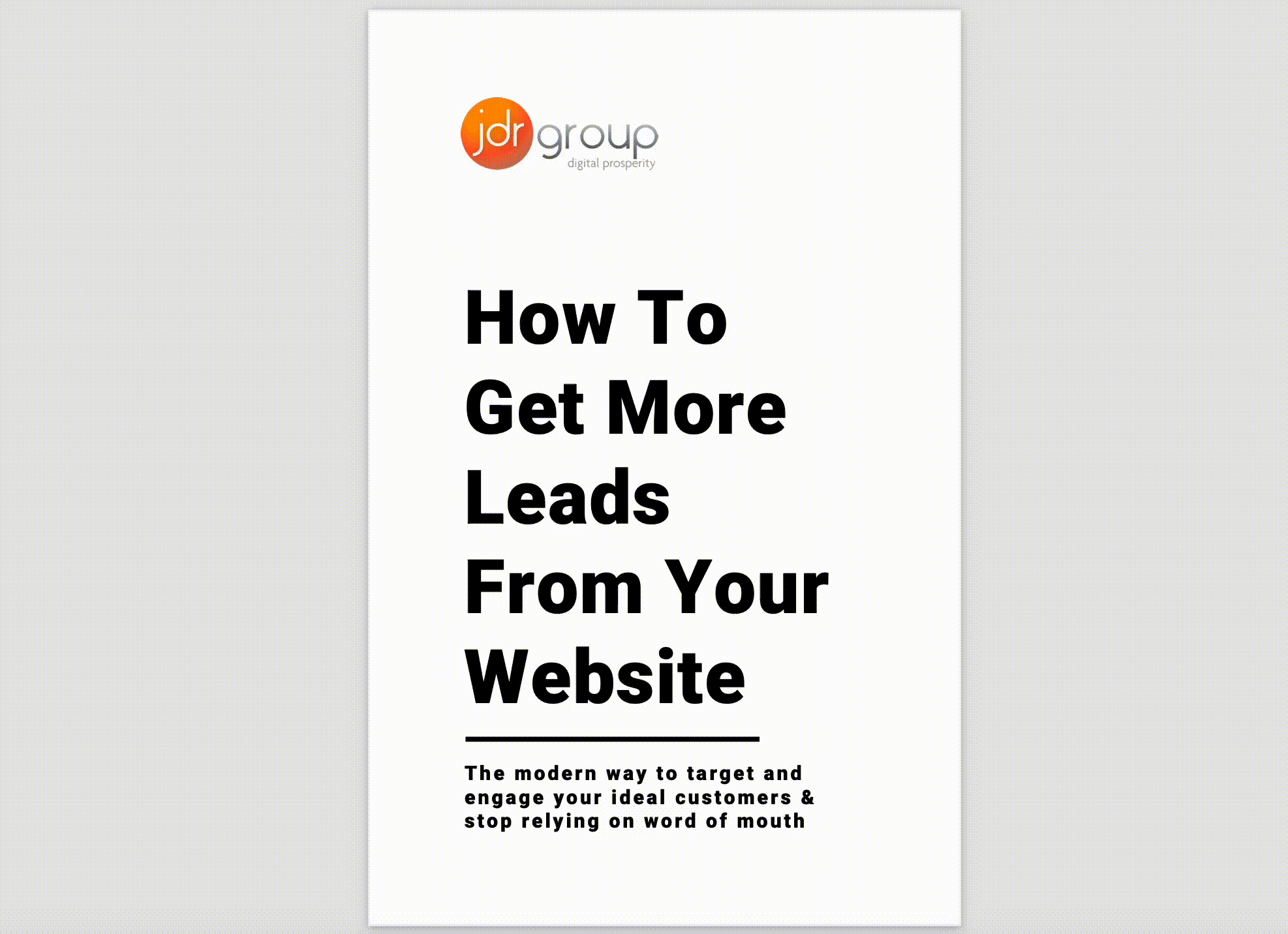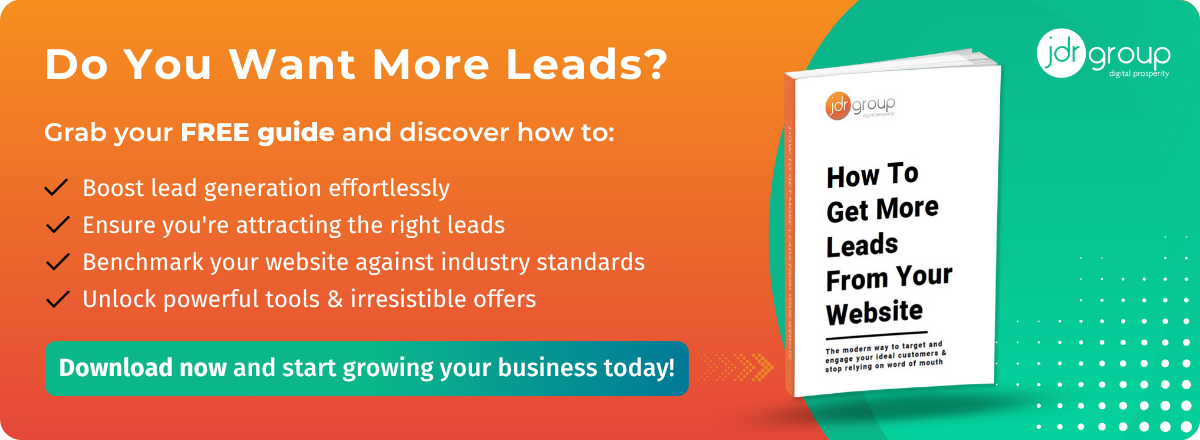


.webp?width=186&height=100&name=meta%20(1).webp)
.webp?width=127&height=100&name=images%20(1).webp)


- Lead Generation
- What Is Lead Generation?
- How To Generate Leads
- Lead Generation Marketing
- Why Not Just Buy Leads
- How To Qualify A Lead
- Lead Generation Benchmarks & Trends
- Leads Generated Per Month, By Annual Revenue
- Leads Per Month
- Lead Generation Strategies
- Tips For Lead Generation Campaigns
- Lead Generation Done For You By JDR Group
- Find Out More
What Is a Lead?
A lead is a person who has indicated interest in your company's product or service in some way, shape, or form.
Example: You took an online survey to learn more about how to take care of your car.
If you got an email from the company that hosted the survey on their website about how they could help you take care of your car, it'd be far less intrusive and irrelevant than if they'd just called you out of the blue with no knowledge of whether you even care about car maintenance, right?
And from a business perspective, the information the company collected about you from your survey responses helps them personalise that opening communication to address your existing problems.
.webp?width=640&height=440&name=Team%20pics%20for%20internal%20pages%20(15).webp)
Lead generation is the process of attracting and converting strangers and prospects into someone who has indicated interest in your company's product or service.
Some examples of lead generators are job applications, blog posts, coupons, live events, and online content.
Whenever someone outside the marketing world asks us what we do, we can't simply say, "We create content for lead generation." It'd be totally lost on them, and we'd get some really confused looks.
So instead, we say, "We work on finding unique ways to attract people to businesses. We want to offer them enough free information to get them naturally interested in companies so they eventually warm up to the business enough to want to hear from them!"
That usually resonates better, and that's exactly what lead generation is: It's a way of warming up potential customers to your business and getting them on the path to eventually buying.
Attract
Convert
Targeted forms, compelling calls to action, and optimised landing pages help turn website visitors into qualified leads.
Close
We move leads toward purchase with smart CRM tools, email nurturing, and automated workflows.
Delight
Through personalised content, surveys, and proactive social engagement, customers are transformed into brand promoters.
How to Generate Leads for
Your Business
Now that we understand how lead generation fits into the whole inbound marketing methodology, let's walk through the steps of the lead generation process.
First, a visitor discovers your business through one of your marketing channels, such as your website, blog, or social media page.
That visitor then clicks on your call-to-action (CTA) — an image, button, or message that encourages website visitors to take some sort of action. The CTA takes your visitor to a web page designed to get contact details of potential customers in exchange for an offer.
An offer is the content or something of value, like an eBook, checklist, webinar or a template. The offer must have enough perceived value to a visitor to merit providing their personal information in exchange for access to it.

Lead Generation Marketing: Strategies to Drive Traffic
and Convert Visitors
Once you put all these elements together, you can start driving potential customers ("traffic") to your landing page to start generating leads.
But how should you promote your landing page? Let’s talk about the front-end of lead generation — lead generation marketing.
If you’re a visual learner, this chart shows the flow from promotional marketing channels to an interested customer or generated lead.
Email, Social and Blog
.webp?width=640&height=440&name=Team%20pics%20for%20internal%20pages%20(7).webp)
Landing Page With Form
.webp?width=640&height=440&name=Team%20pics%20for%20internal%20pages%20(9).webp)
Offer Given & Lead Generated
.webp?width=640&height=440&name=Team%20pics%20for%20internal%20pages%20(10).webp)
Other Channels
There are even more channels you can use to get visitors to become leads. Let’s go into depth on these and talk about a few others.
.webp?width=640&height=440&name=Team%20pics%20for%20internal%20pages%20(11).webp)
Content Marketing
Content is useful, free information - whether an e-book, a blog post, a video, or an infographic, content is a great way to guide users to your website so they can start to get to know your business and what you can offer them. The more delighted a visitor is with your content, the more likely they are to trade contact details in exchange for more content.
.webp?width=640&height=440&name=Team%20pics%20for%20internal%20pages%20(12).webp)
Google Ads (PPC) and Remarketing
The sole purpose of an ad is to get people to take an action. Otherwise, why spend the money? If you want people to convert, be sure that your website matches exactly what is promised in the ad, and that the action you want users to take is clear.
.webp?width=640&height=440&name=Team%20pics%20for%20internal%20pages%20(13).webp)
Email Marketing
Email is a great place to reach the people who already know your brand and product or service - these are the people who have already given you their email address in exchange for content. It’s much easier to ask them to sell to them since they’ve already shown interest in your business.
.webp?width=640&height=440&name=Team%20pics%20for%20internal%20pages%20(16).webp)
Blogging
The great thing about using your blog posts to promote an offer is that you can tailor the entire piece to the end goal. So, if your offer is an instructional video on setting up Google Search Console, then you can write a blog post about how to select your marketing metrics ... which would make your video, or CTA, highly relevant and easy to click.
.webp?width=640&height=440&name=Team%20pics%20for%20internal%20pages%20(18).webp)
Social Media Marketing
Social media platforms such as Facebook and LinkedIn make it easy to guide your followers to take action. You can also promote your offerings on your social media posts and include a call-to-action in your caption.
.webp?width=640&height=440&name=Team%20pics%20for%20internal%20pages%20(14).webp)
Product Trials
You can break down a lot of barriers to a sale by offering trials of your product or service. Once a prospect is using your product, you can entice them with added offers or resources to encourage them to buy. Another good practice is to include your branding in your free versions so you can capture other potential customers, too.
Why Not Just Buy Leads?
%20(1).webp?width=2000&height=1375&name=Team%20pics%20for%20internal%20pages%20(8)%20(1).webp)
Marketers and salespeople alike want to get leads— and they want to get them quickly.
The temptation to buy leads. Buying leads, as opposed to getting them naturally, is much easier and takes far less time and effort, despite being more expensive. But you might be paying for advertising anyway ... so, why not just buy leads?
First, any leads you've purchased don't actually know you. Typically, they've "opted in" at some other site when signing up for something, and didn't actually opt in to receiving anything from your company.
The messages you send them are, therefore, unwanted messages, and sending unwanted messages is intrusive.
If the prospect has never been to your website and indicated an interest in your products or services, then you’re interrupting them.
If they’ve never opted in to receive messages from you, then there’s a high chance they could flag your message as spam, which isn’t good for business. It’s always better to generate leads organically than to buy them.
How to Identify and Qualify Leads
As we covered in the first section, a lead is a person who has indicated interest in your company's product or service.
Now, let's talk about the ways in which someone can actually show that interest.

Where Qualified Leads Begin
Essentially, a sales lead is generated through information collection. That information collection could come as the result of a job seeker showing interest in a position by completing an application, a shopper sharing contact information in exchange for a discount code, or a person filling out a form to download an educational piece of content.
Read more in our article 'How to qualify leads & avoid wasting time'.
Gauging a Lead’s Level of Interest
Below are just a few of the many ways in which you could qualify someone as a lead. Each of these examples shows that the amount of collected information used to qualify a lead, as well as the lead level of interest, can vary.
Let's assess each scenario:
.webp?width=2000&height=1375&name=Team%20pics%20for%20internal%20pages%20(19).webp)
Job Application
An individual that fills out an application form is willing to share a lot of personal information because he/she wants to be considered for a position.
Filling out that application shows their true interest in the job, therefore qualifying the person as a lead for the company's recruiting team — not marketing or sales teams.

Discount Code
Unlike the job application, you probably know very little about someone who has stumbled upon one of your online discount codes.
But if they find the discount valuable enough, they may be willing to give you their name and email address in exchange for it. Although it's not a lot of information, it's enough for a business to know that someone has interest in their company.
.webp?width=2000&height=1375&name=Team%20pics%20for%20internal%20pages%20(5).webp)
Content
While signing up for a discount code shows an individual has a direct interest in your product or service, content (like an educational ebook or webinar) doesn’t.
So to truly understand the nature of the person's interest in your business, you'll probably need to collect more information to decide whether the person is interested in your product or service and whether they're a good fit.
These three general examples highlight how lead generation differs from company to company, and from person to person.
You'll need to collect enough information to gauge whether someone has a true, valid interest in your product or service — how much information is enough information will vary depending on your business.
Know Your Numbers: What Success Looks Like
Understanding lead volume and cost trends can help you set realistic goals, spot growth opportunities, and fine-tune your strategy.
Here's a look at how companies across different industries and revenue levels are performing when it comes to lead generation:
Lead Generation Benchmarks and Trends
Recent data reveals a strong link between lead volume and business success.
Companies generating fewer than 100 leads per month make up 70% of those falling short of their revenue goals. In contrast, just 5% of companies break past the 2,500-lead mark; yet they're often the ones seeing the strongest results.
Leads Generated per month, by annual revenue
Unsurprisingly, the more revenue a company has, the more leads they generate. The differences are most drastic at the highest and lowest end of the spectrum:
82% of companies with £150,000 or less in annual revenue report generating less than 100 leads per month, whereas only 8% of companies generating £70m+ in annual revenue report less than 100 leads per month.
Cost Per Lead Benchmarks By Industry
The cost per lead varies by industry, with Media & Advertising reporting the lowest cost per lead. Software, IT, Marketing Agencies & Financial Services all report the highest average cost per lead at £30-75.
Leads per month
58% of companies generate 500 leads per month or fewer, and 71% generate 1,000 or fewer. But as we saw previously, the companies having the most success are also the ones generating the most leads.
Lead Generation Strategies
Online lead generation encompasses a wide range of tactics, campaigns, and strategies. We talked about lead capture once you have a visitor on your site ... but how can you get them there in the first place?
Let’s dive into lead generation strategies for a few popular platforms.
Social Media Lead Generation
Facebook, LinkedIn and Twitter have been methods for lead generation since its start. Facebook created lead ads which you can run in your Facebook Advertising, and also has a feature that lets you put a simple call-to-action button at the top of your Facebook page, helping you send Facebook followers directly to your website. Twitter lets you generate leads within one quick Tweet, and LinkedIn created lead generation forms specifically for getting potential lead contact information as part of running
LinkedIn Advertising.
Google Ads/PPC Lead Generation
When we say pay-per-click (PPC), we’re referring to ads on search engine result pages. These are paid for by you, and a PPC advert places your business near the top of a search page, if someone is looking for your services.
Google gets 3.5 billion searches a day, making it prime real estate for any ad campaign, especially lead generation. The effectiveness of your PPC campaign relies on things such as your budget, search words that your website and your customers have in common, and a few other factors.
How To Get More Leads From Your Website Guide

Do you want more leads?
Download your FREE copy today to get a clear insight into how you can target and engage your ideal customers.
You will learn:
- How to get more leads from your website - without needing more traffic
- How to qualify so you know you are getting the right leads
- Industry benchmarks - is your website under-performing?
- How to use the correct tools and create amazing offers for your website
Simply confirm your details and get instant access to your free copy now!
5 Tips for Lead Generation Campaigns
In any given lead generation campaign, there can be a lot of moving parts. It can be difficult to tell which parts of your campaign are working and which need some fine-tuning.
What exactly goes into a best-in-class lead generation engine? Here are a few tips when building lead generation campaigns.
The most successful marketing teams use a formal system to organise and store their leads. That's where lead generation tools and lead generation software come into play.
How much do you know about the people visiting your website? Do you know their names or their email addresses? How about which pages they visited and what they do before and after filling out a form that gives you their contact information?
If you don't know the answers to these questions, chances are you're having a hard time connecting with the people who are visiting your site. These are questions you should be able to answer — and you can with the right lead generation tools.
Not all your site visitors are ready to talk to your sales team or see a demo of your product. Someone at the beginning of the buyer's journey might be interested in an informational piece of content like an ebook or a guide, whereas someone who's more familiar with your company and almost ready to buy might be more interested in a free trial or demo.
Make sure you're creating offers for each phase and offering CTAs for these offers throughout your site.
Yes, it takes time to create valuable content that educates and makes a great impression, but if you don't offer anything for visitors who aren't ready to buy, then they may never come back to your website.
It's important to look at content as an investment - a few hours of your time today, for years’ worth of interest from potential customers.
The most successful lead generation campaigns are the ones that deliver on what they promise. Make sure that you’re presenting a consistent message throughout your content and advertising, and providing value to everyone that lands on your website.
Your campaign should be about more than just obtaining an email address — it should be about developing a new customer. Think about what would impress that customer, and then mirror your website to reflect that.
This may seem obvious to you, but you'd be surprised how many marketers don't create dedicated pages for their offers. CTAs are meant to send visitors to a landing page where they can receive a specific offer.
Don't use CTAs to drive people to your homepage, for instance. Even if your CTA is about your brand or product (and perhaps not an offer like a download), you should still be sending them to a targeted landing page that's relevant to what they are looking for and includes an opt-in form. If you have the opportunity to use a CTA, send them to a page that will convert them into a lead.
Every time a person lands on your Facebook, Twitter, or LinkedIn, you can capture their interest - or not. Make the most of that opportunity and enhance your social media accounts.
Start by adding links directly to the landing pages of successful offers within your Facebook, Twitter, LinkedIn, and other social media posts. Tell visitors that you're sending them to a landing page. That way, you're setting expectations.
Book A Call
Book an initial 30-minute online chat with Andy to find out:
-
How we can help you achieve your goals
-
How you can improve your sales and marketing
-
And get useful, actionable tips & advice
The UK's Top Digital Marketing Agency For Small & Medium Sized Businesses
Most business owners don’t want better marketing. What they actually want is better sales.
But you can’t just get more sales by running a Facebook Ads campaign, updating your website or sending out an email campaign.
You need a complete system.
And you need a marketing agency that know how to get you there.
One that has done it for hundreds of businesses like yours. One that can tailor a strategy for the unique needs of your business.
Why Choose JDR As Your Digital Marketing Agency?
Work with the UK's leading inbound agency for SME's - and one of the top HubSpot partners in the world
With JDR Group as your inbound marketing agency, you'll get the support of an entire marketing team, following proven systems, and access to the modern technology and tools your business needs to achieve your goals. You'll also get:
A tailored programme for the unique needs of your business
Expertise and experience (read our case studies, and read our reviews to see for yourself)
A team who are as passionate about growing your business as you are
We know that you don't just want an Inbound Marketing Agency. You want more leads, more sales - and that means a better strategy, website conversion, multiple marketing channels, a proper system to convert leads into sales, automated follow up systems, and a way of tracking and measuring it all.
As a business coaching company originally, we know how to grow companies - and can help you grow yours.



.webp?width=186&height=100&name=meta%20(1).webp)
.webp?width=127&height=100&name=images%20(1).webp)








